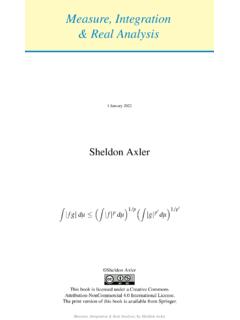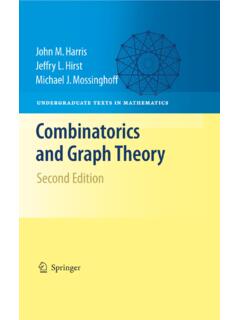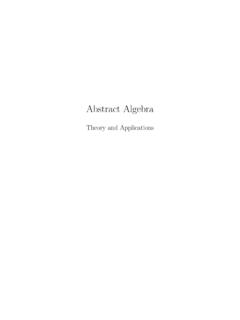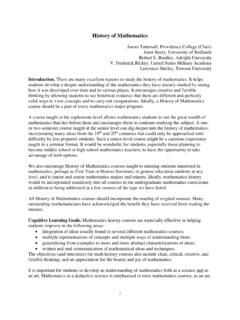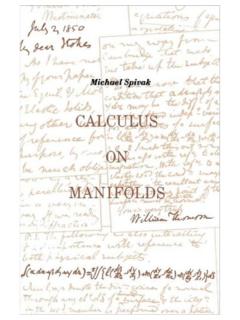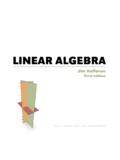Transcription of Introduction to Tensor Calculus for General Relativity
1 Massachusetts Institute of Technology Department of Physics Physics Spring 1999. Introduction to Tensor Calculus for General Relativity c 1999 Edmund Bertschinger. All rights reserved. 1 Introduction There are three essential ideas underlying General Relativity (GR). The first is that space- time may be described as a curved, four-dimensional mathematical structure called a pseudo-Riemannian manifold. In brief, time and space together comprise a curved four- dimensional non-Euclidean geometry. Consequently, the practitioner of GR must be familiar with the fundamental geometrical properties of curved spacetime. In particu- lar, the laws of physics must be expressed in a form that is valid independently of any coordinate system used to label points in spacetime.
2 The second essential idea underlying GR is that at every spacetime point there exist locally inertial reference frames, corresponding to locally flat coordinates carried by freely falling observers, in which the physics of GR is locally indistinguishable from that of special Relativity . This is Einstein's famous strong equivalence principle and it makes General Relativity an extension of special Relativity to a curved spacetime. The third key idea is that mass (as well as mass and momentum flux) curves spacetime in a manner described by the Tensor field equations of Einstein. These three ideas are exemplified by contrasting GR with Newtonian gravity. In the Newtonian view, gravity is a force accelerating particles through Euclidean space, while time is absolute.
3 From the viewpoint of GR, there is no gravitational force. Rather, in the absence of electromagnetic and other forces, particles follow the straightest possible paths (geodesics) through a spacetime curved by mass. Freely falling particles define locally inertial reference frames. Time and space are not absolute but are combined into the four-dimensional manifold called spacetime. Working with GR, particularly with the Einstein field equations, requires some un- derstanding of differential geometry. In these notes we will develop the essential math- ematics needed to describe physics in curved spacetime. Many physicists receive their 1. Introduction to this mathematics in the excellent book of Weinberg (1972).
4 Weinberg minimizes the geometrical content of the equations by representing tensors using com- ponent notation. We believe that it is equally easy to work with a more geometrical description, with the additional benefit that geometrical notation makes it easier to dis- tinguish physical results that are true in any coordinate system ( , those expressible using vectors) from those that are dependent on the coordinates. Because the geometry of spacetime is so intimately related to physics, we believe that it is better to highlight the geometry from the outset. In fact, using a geometrical approach allows us to develop the essential differential geometry as an extension of vector Calculus .
5 Our treatment is closer to that Wald (1984) and closer still to Misner, Thorne and Wheeler (1973). These books are rather advanced. For the newcomer to General Relativity we warmly recom- mend Schutz (1985). Our notation and presentation is patterned largely after Schutz. The student wishing additional practice problems in GR should consult Lightman et al. (1975). A slightly more advanced mathematical treatment is provided in the excellent notes of Carroll (1997). These notes assume familiarity with special Relativity . We will adopt units in which the speed of light c = 1. Greek indices ( , , etc., which take the range {0, 1, 2, 3}). will be used to represent components of tensors. The Einstein summation convention is assumed: repeated upper and lower indices are to be summed over their ranges, , A B A0 B0 + A1 B1 + A2 B2 + A3 B3.
6 Four-vectors will be represented with an arrow over the symbol, , A, ~ while one-forms will be represented using a tilde, Spacetime points will be denoted in boldface type; , x refers to a point , B. with coordinates x . Our metric has signature +2; the flat spacetime Minkowski metric components are = diag( 1, +1, +1, +1). 2 Vectors and one-forms The essential mathematics of General Relativity is differential geometry, the branch of mathematics dealing with smoothly curved surfaces (differentiable manifolds). The physicist does not need to master all of the subtleties of differential geometry in order to use General Relativity . (For those readers who want a deeper exposure to differential geometry, see the introductory texts of Lovelock and Rund 1975, Bishop and Goldberg 1980, or Schutz 1980.)
7 It is sufficient to develop the needed differential geometry as a straightforward extension of linear algebra and vector Calculus . However, it is important to keep in mind the geometrical interpretation of physical quantities. For this reason, we will not shy from using abstract concepts like points, curves and vectors, and we will distinguish between a vector A~ and its components A . Unlike some other authors ( , Weinberg 1972), we will introduce geometrical objects in a coordinate-free manner, only later introducing coordinates for the purpose of simplifying calculations. This approach 2. requires that we distinguish vectors from the related objects called one-forms. Once the differences and similarities between vectors, one-forms and tensors are clear, we will adopt a unified notation that makes computations easy.
8 Vectors We begin with vectors. A vector is a quantity with a magnitude and a direction. This primitive concept, familiar from undergraduate physics and mathematics , applies equally in General Relativity . An example of a vector is d~x, the difference vector between two infinitesimally close points of spacetime. Vectors form a linear algebra ( , a vector space). If A~ is a vector and a is a real number (scalar) then aA ~ is a vector with the same direction (or the opposite direction, if a < 0) whose length is multiplied by |a|. If A~ and B~ are vectors then so is A. ~ + B. ~ These results are as valid for vectors in a curved four-dimensional spacetime as they are for vectors in three-dimensional Euclidean space.
9 Note that we have introduced vectors without mentioning coordinates or coordinate transformations. Scalars and vectors are invariant under coordinate transformations;. vector components are not. The whole point of writing the laws of physics ( , F~ = m~a). using scalars and vectors is that these laws do not depend on the coordinate system imposed by the physicist. We denote a spacetime point using a boldface symbol: x. (This notation is not meant to imply coordinates.) Note that x refers to a point, not a vector. In a curved spacetime the concept of a radius vector ~x pointing from some origin to each point x is not useful because vectors defined at two different points cannot be added straightforwardly as they can in Euclidean space.
10 For example, consider a sphere embedded in ordinary three-dimensional Euclidean space ( , a two-sphere). A vector pointing east at one point on the equator is seen to point radially outward at another point on the equator whose longitude is greater by 90 . The radially outward direction is undefined on the sphere. Technically, we are discussing tangent vectors that lie in the tangent space of the manifold at each point. For example, a sphere may be embedded in a three-dimensional Euclidean space into which may be placed a plane tangent to the sphere at a point. A two- dimensional vector space exists at the point of tangency. However, such an embedding is not required to define the tangent space of a manifold (Walk 1984).










